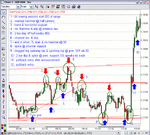Hi,
There is a lot written about pivot points, how to enter a trade using them, how to calculate them etc. But there is very little written about an exit strategy for pivot points. I was wondering how people exit a trade that was opened from a pivot point indicator.
Some people suggest using the pivot point itself as a place to put the stop loss, but in fast moving markets, and especially after the breakout it can dip back below the pivot price briefly before moving off again so this would be too close. This is assuming your trade goes wrong, but what about if you get it right, do you sell after the first sign of a pull back after a breakout.
I'd be interested to know how you guys exit a pivot point trade
cheers
There is a lot written about pivot points, how to enter a trade using them, how to calculate them etc. But there is very little written about an exit strategy for pivot points. I was wondering how people exit a trade that was opened from a pivot point indicator.
Some people suggest using the pivot point itself as a place to put the stop loss, but in fast moving markets, and especially after the breakout it can dip back below the pivot price briefly before moving off again so this would be too close. This is assuming your trade goes wrong, but what about if you get it right, do you sell after the first sign of a pull back after a breakout.
I'd be interested to know how you guys exit a pivot point trade
cheers

